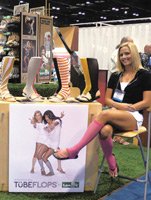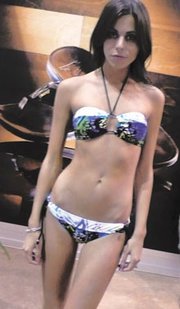Surf Expo Concise, Focused Buying
ORLANDO, FLA.—Trade shows reflect the market, and Surf Expo’s Aug. 20–22 edition was no exception.
Held at the Orange County Convention Center in Orlando, Fla., the show saw its square footage shrink while attendance dropped 15 percent. Still, the show managed to attract 700 new retailers and a total of 5,200 buyers.
Roy Turner, Surf Expo’s director, pointed out that while the show’s skate division was considerably smaller this edition, the surf division managed to keep the same number of brands even while the footprint of the section shrank. The drop in attendance is in part attributed to the shift in dates, which put the show a month before its usual September run, and the fact that retailers are opting to slim down the number of buyers they bring to the show. “The aisles weren’t packed—I’ll be the first to tell you that—but the booths were busy. The buyers that did come were ready to spend money. In the current economy, I’ll take it,” he said.
Vendors, who saw their ranks change as some key brands (including biggies such as Hurley and Nike) sat out the East Coast show, greeted the show with a stiff upper lip. “We’re all back in school. Nothing is like it used to be, and we’re all getting used to our new reality,” said Mike Martin, vice president of sales and marketing for Irvine, Calif.–based Ezekiel.
The show—which included wake, wind, swim, boutique and resort categories on top of the surf and skate offerings—had a no-nonsense feel that even Volcom’s frat-house version of a luau booth could not disturb.
Quiksilver, the surf-industry giant, opted out of its standard gargantuan custom booth for a campground-style setup that revolved around its RV driven in from California. Roxy, Quiksilver’s women’s division, opted for the same approach. Dave Rosenberger, Quiksilver’s vice president and national sales manager for the brand’s young men’s and wintersports divisions, said the move saved the company a sizable chunk of the cost of participating in the show. Quik will take the same tack at the Action Sports Retailer Trade Expo in San Diego Sept. 10–12. “It’s a great option for us, and I think it captures what Quiksilver’s about. We’re here to work,” Rosenberger said.
The new setup went over well with retailers, and Rosenberger said he didn’t notice a drop-off of buyers in the booth, which enjoyed steady traffic. The addition of Quiksilver’s women’s collection, which showed its first full collection of swimwear as well as fashion-forward contemporary offerings, and its Waterman collection added a dose of newness to the booth. Another change was the introduction of a new segmentation strategy for the Quiksilver brand. Key to the new strategy is the introduction of the “Core Collection,” which is made up of technical boardshorts, T-shirts and other items that will be sold exclusively to core retailers and will not be sold on the brand’s own consumer-direct e-tail site.
Several other brands—including Ezekiel, Lost, O’Neill, Rusty and Reef—also changed up their look and opted for cost-efficient turn-key booths at Surf Expo. “We’ve stopped peacocking for each other. Now it’s about our product, not our feathers. We’re saving our feathers for the consumers,” as Ezekiel’s Martin gamely put it.
The cost-cutting measure didn’t take away from the business being done inside the booths. Reef, which this year slashed its offerings to focus on its footwear and swimwear, debuted its newly licensed women’s swimwear collection. The collection, produced by Tustin, Calif.–based Raj Manufacturing, featured bikinis, mono-kinis and coverups geared toward a more “all-American” market.
Rip Curl’s “it” item for the season was the Mirage boardshort, which Dylan Slater, the brand’s marketing director, deemed the best boardshort Rip Curl has ever produced. “We feel very confident about it,” Slater said.
Atwater focused on updating its basics, offering slimmer and shorter silhouettes on shorts and slightly edgy riffs on the skinny-jeans trend with a skinny denim cut-off. Fox launched its women’s swimwear at the show, which features 16 moderate-coverage suits in prints inspired by the women’s apparel collection. The collection will be sold as sets and retail for $78 to $84, said Tiana Becker, Fox’s juniors sales manager. Boardshorts proved to be Fox’s most important menswear category, said Jeff Shine, a key account executive with the brand. The debut of the Q4, a new four-way stretch boardshort and the brand’s most technical version yet, earned the most interest.
Despite a focus on basics, there were some non-basics getting action at Surf Expo. Sanuk launched its newest women’s style, the Tube Flop, which is equal parts tube sock and flip-flop. Originally intended for more fashion-minded retailers, the Tube Flop enjoyed interest from core retailers and outdoor retailers, said John Gothard, Sanuk’s vice president of sales. “It’s unexpected but welcome,” he said. Tube Flops wholesale for $15 or $12 if pre-booked.
Dates for Surf Expo’s 2010 shows have not yet been set, but the show organizers said they will be deferring to vendors’ and buyers’ wishes. A survey was sent to participants and will determine next year’s dates.


























